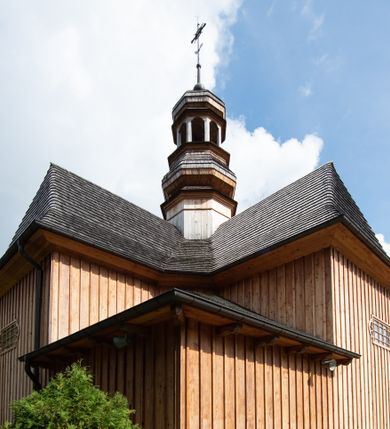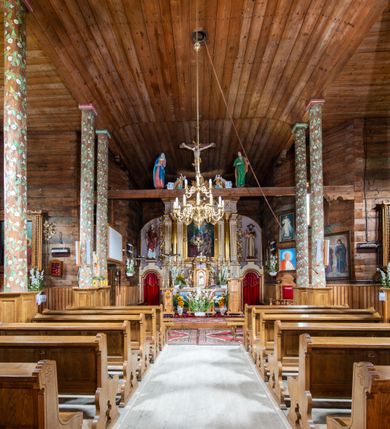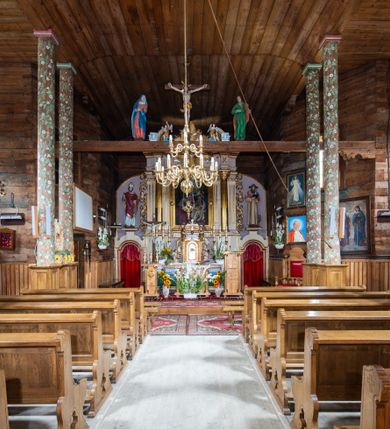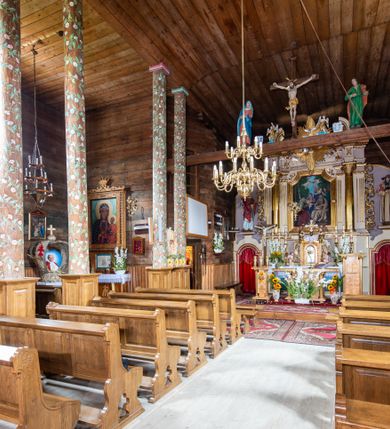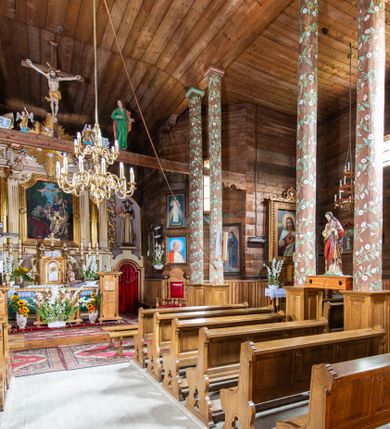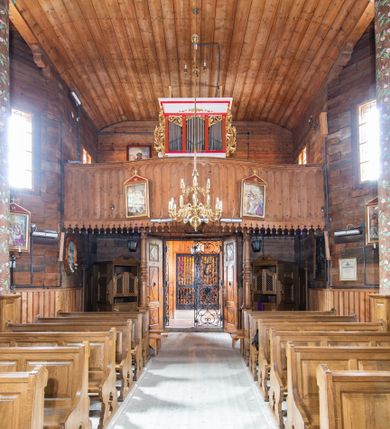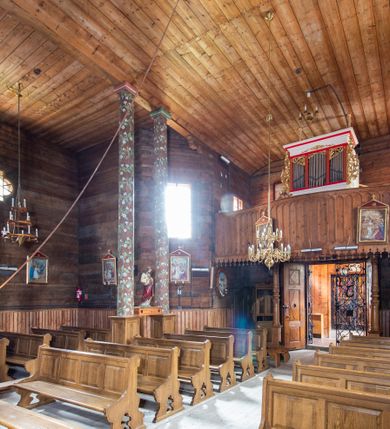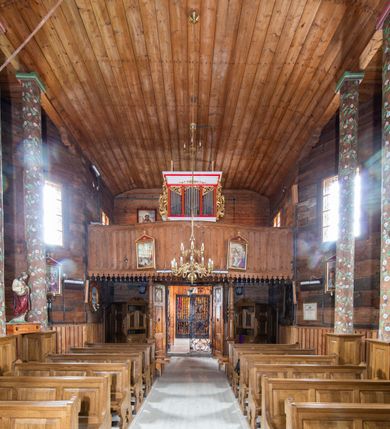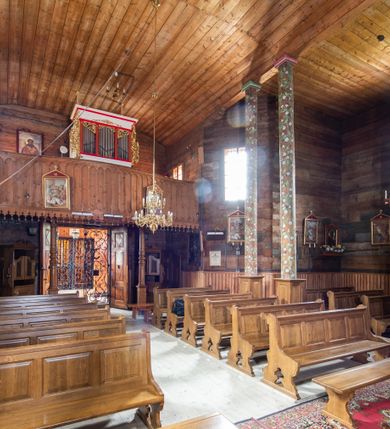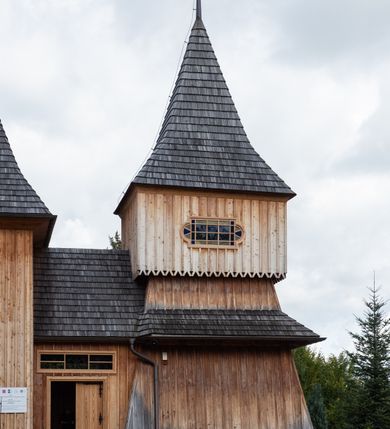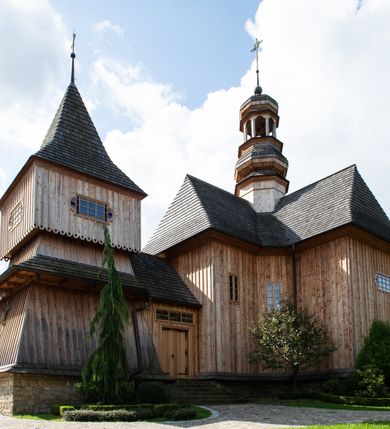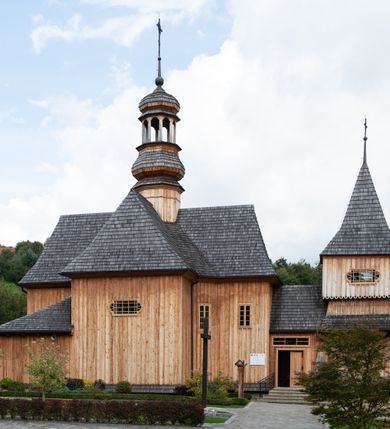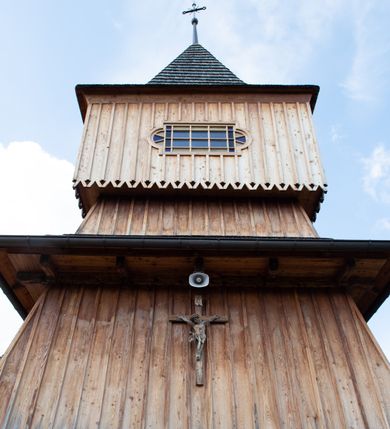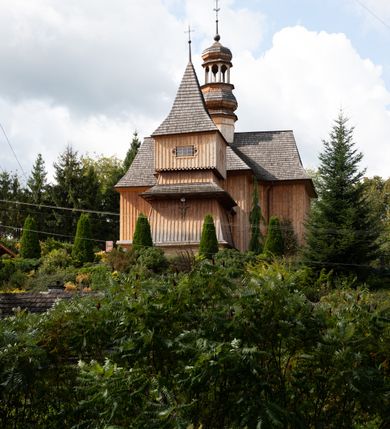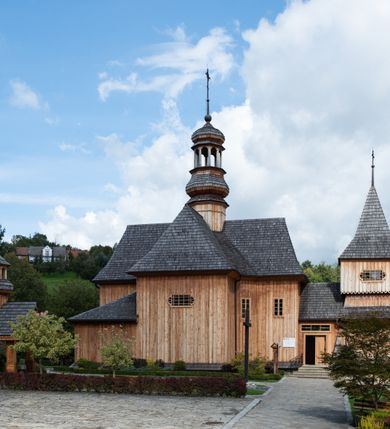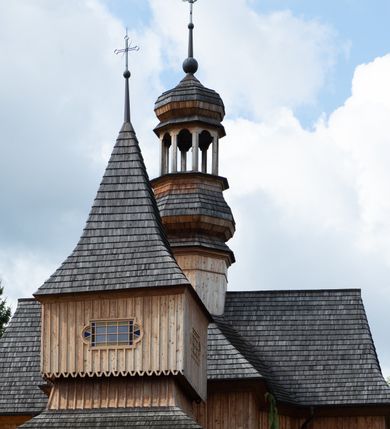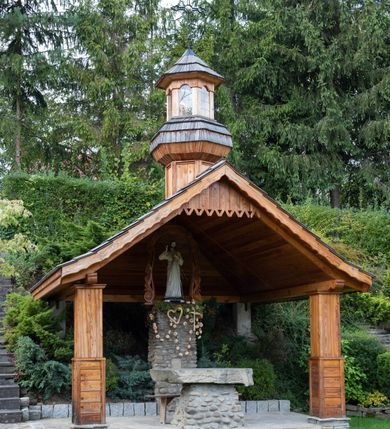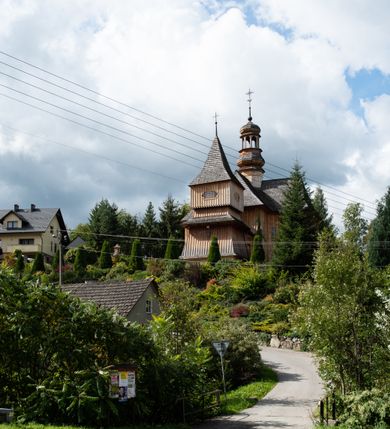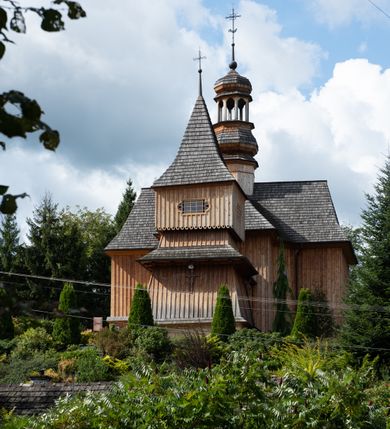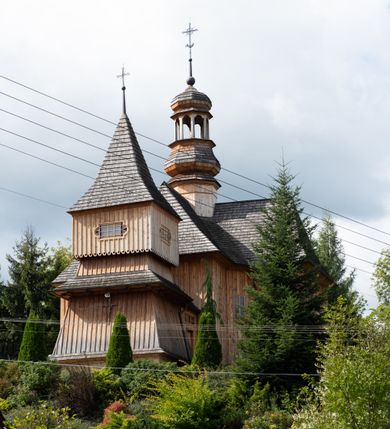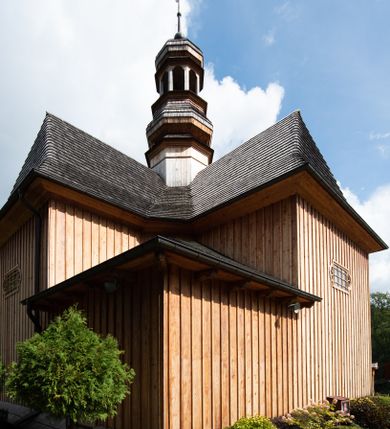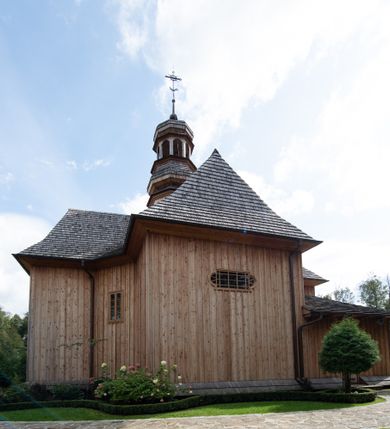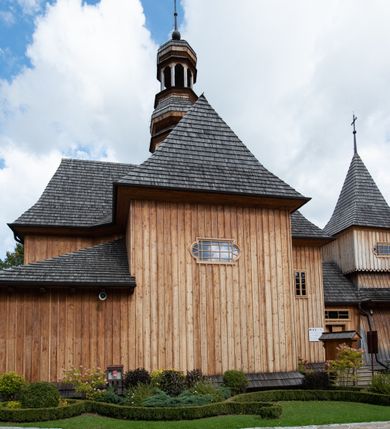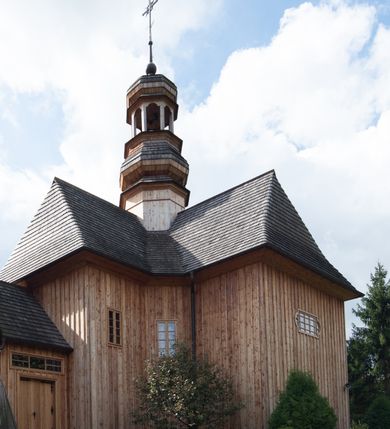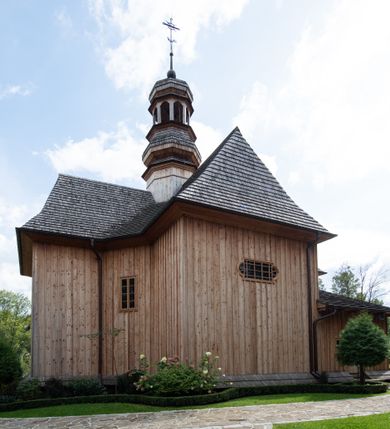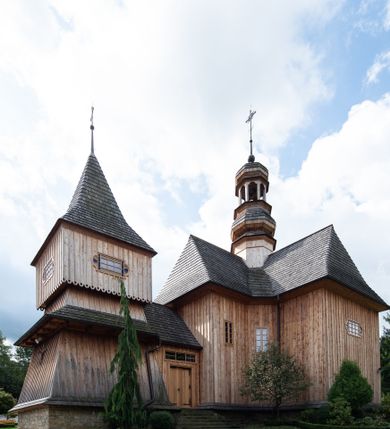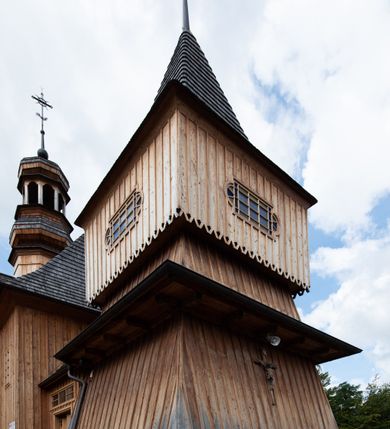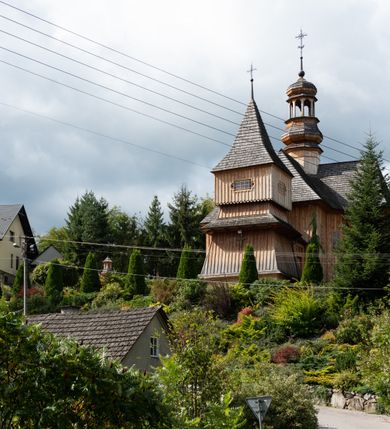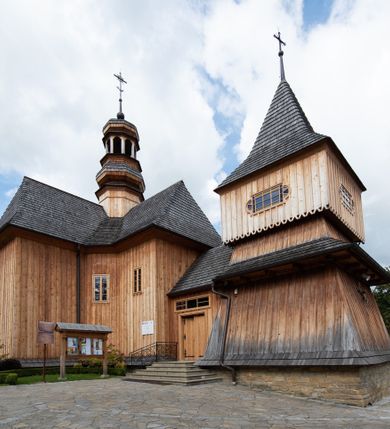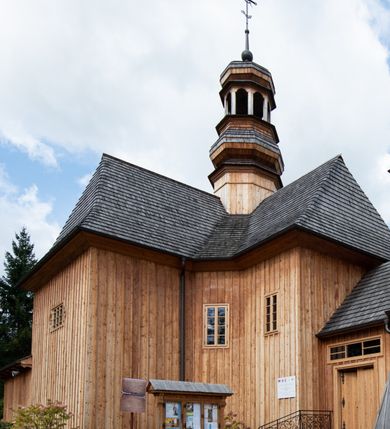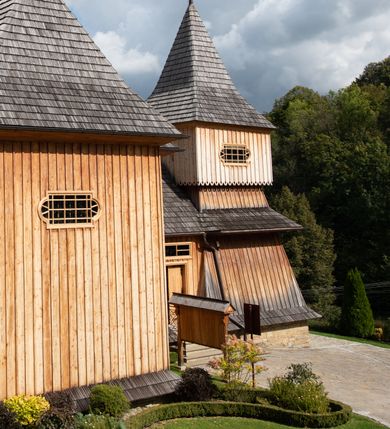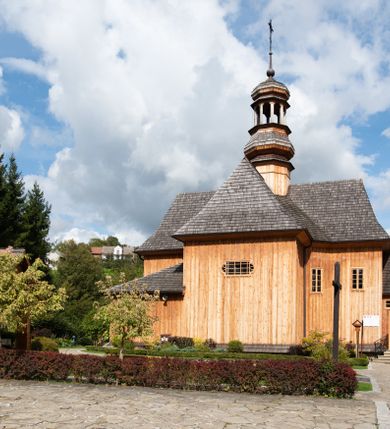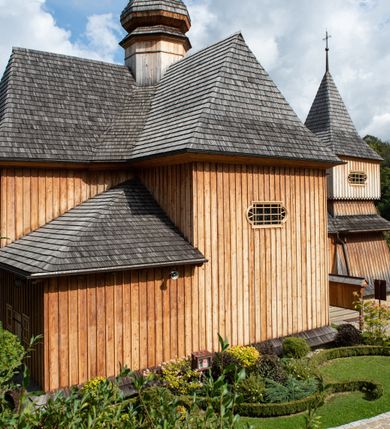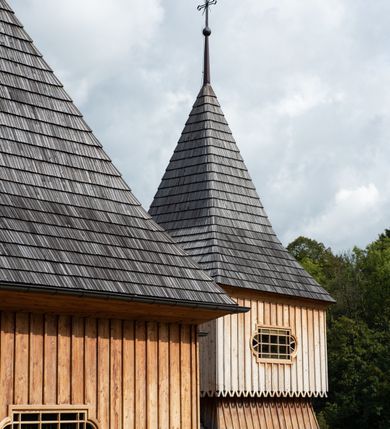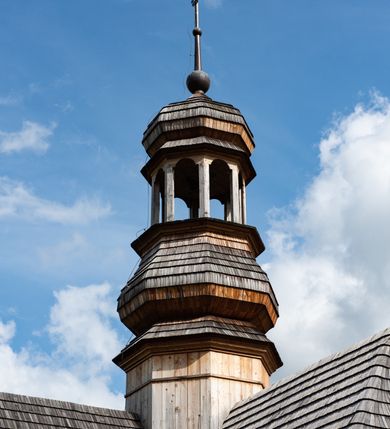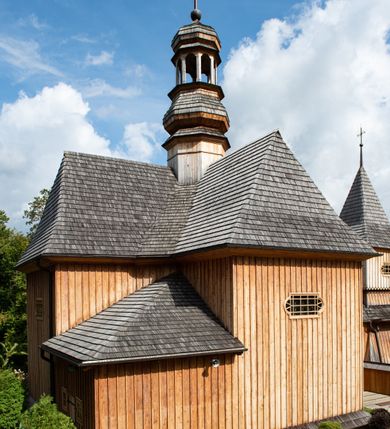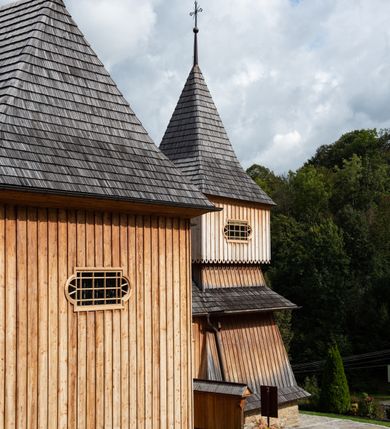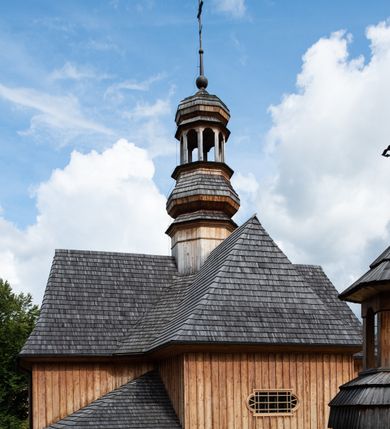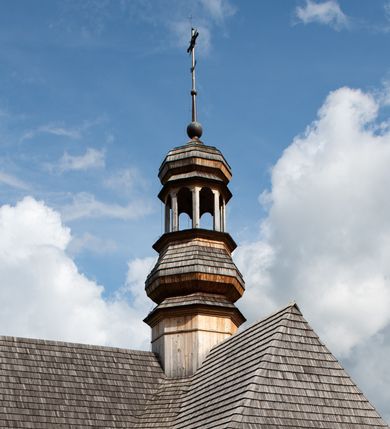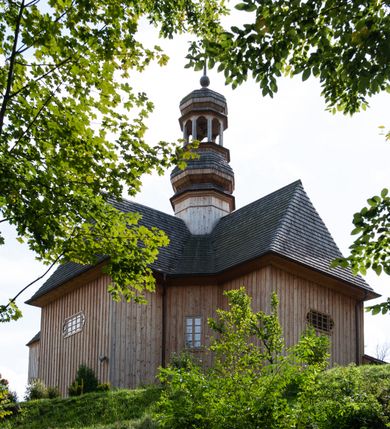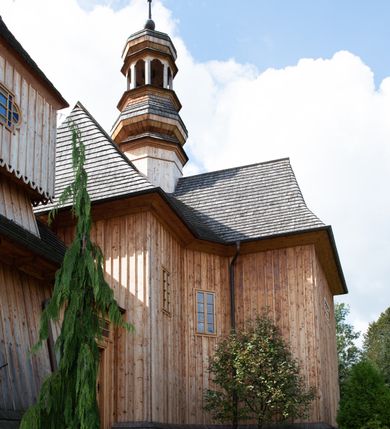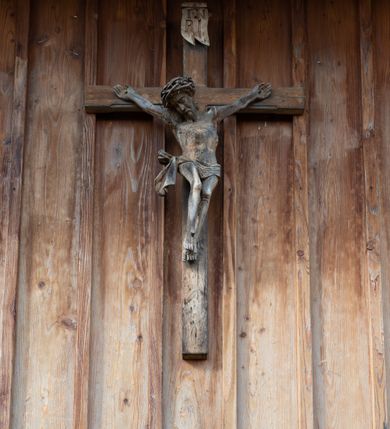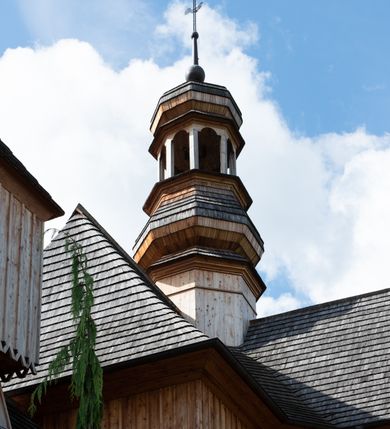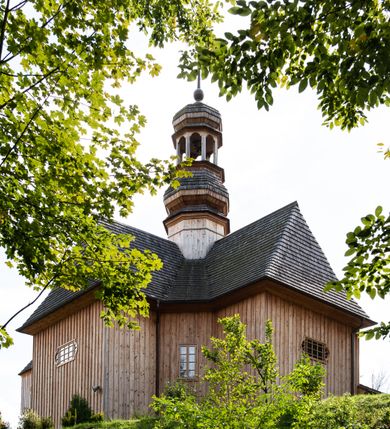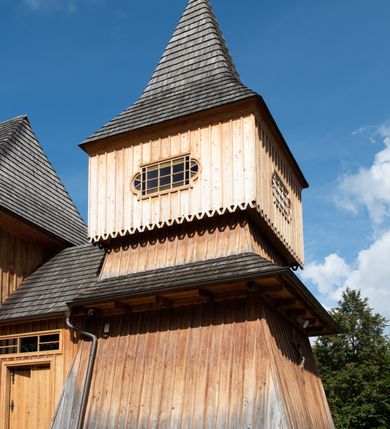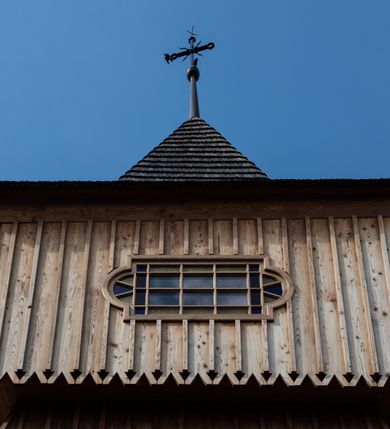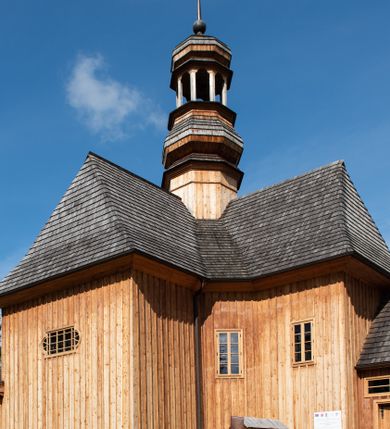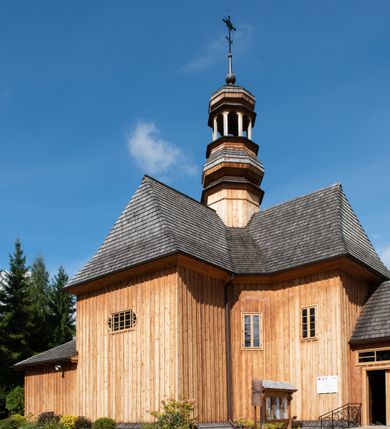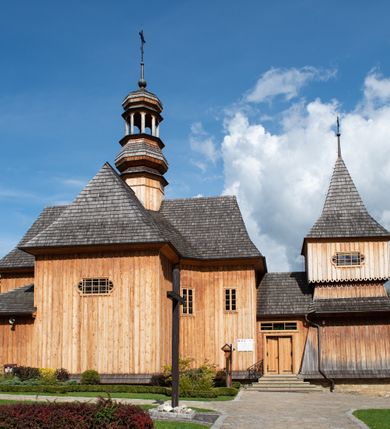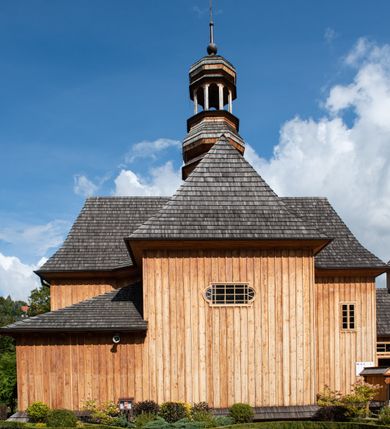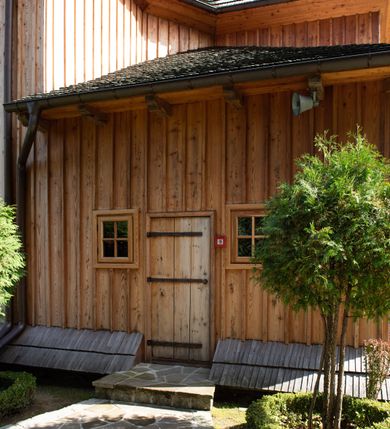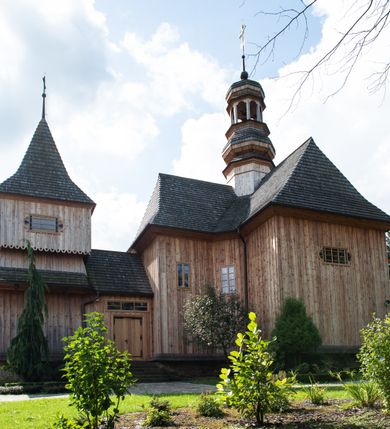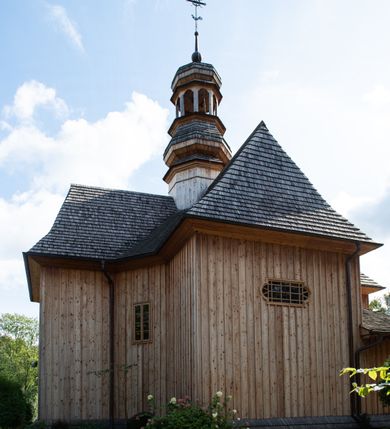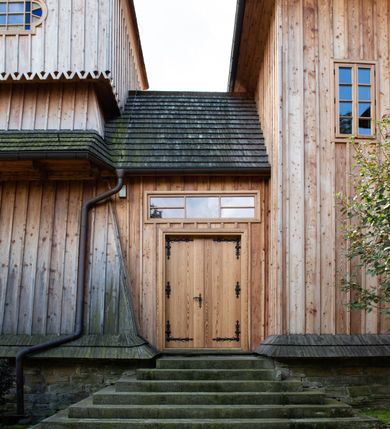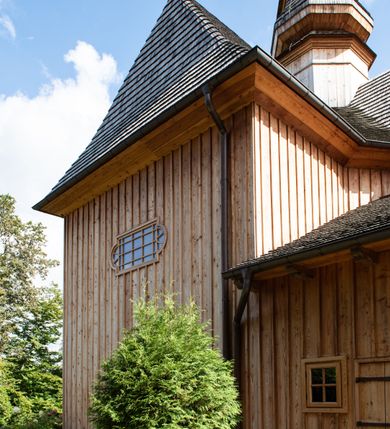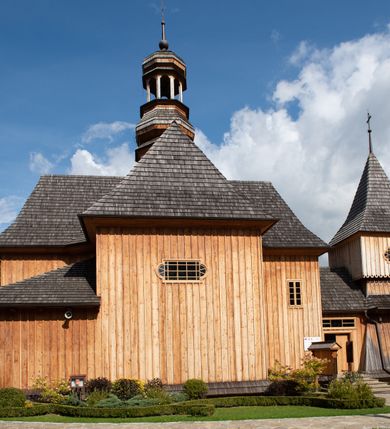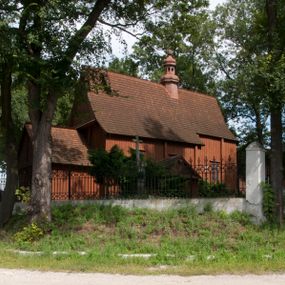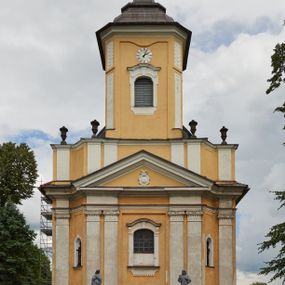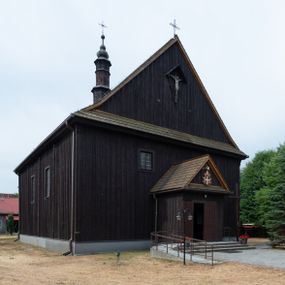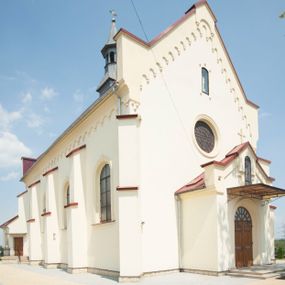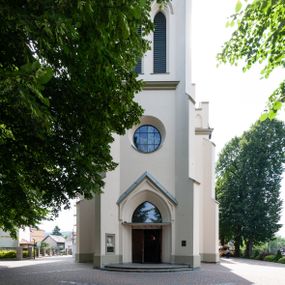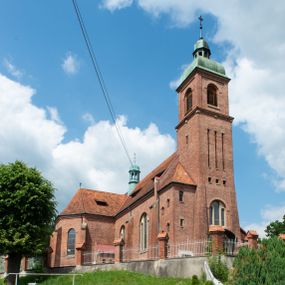
Church of Saint Joachim in Skawinki
Place
Skawinki
Parish
St. Joachim's parish in Skawinki
Identifier
DZIELO/12702
Amount
1
Catalogue note author
Maria Działo
History of work
Church of Saint Joachim in Skawinki was moved to Przytkowice, where it was built by heir of Przytkowice, prince Jóżef Czartoryski in 1733 under the invocation of Saint Catherine the Lady and Martyr. The church was described in the records of episcopal visitation in 1748. It was mentioned therein that the church was erected in 1733, however it was not consecrated: „Ecclesia Parochialis in Przytkowice 1733 anno constructa, lignea, scandulis tecta, sub Titulo antiquae Ecclesiae, alius Sancta Catharina Virginis et Martyris, non consecrata (…)”. The records of the previous visits mention the monuments transferred to the new church. According to the inventory from 1891, the church was "tastefully and beautifully repainted in 1889 for the amount of 240 zlotys". The inventory also includes the furnishings of the church: "The Great Altar with a permanent painting of the Holy Trinity and a sliding painting of the Holy Family created using wood carving which was renovated, varnished and glided. On the right from the Graet Altar, i.e. on the same side where the Gospel is located, there is a side altar with the sliding painting of Katarzyna P. M., a patroness of the church. Behind it, there is a painting of Virgin Mary, renovated, created using wood carving, painted, varnished and glided. On the left side of the Great Altar, on the side of the Epistle, there is a side altar of Jesus on the cross, painted on canvas and antique. All these altars are made of soft wooden material, carved, gilded, varnished and painted in various ways. Moreover, the inventory also includes three confessionals, pews, pulpit, organ, bells, baptismal font, paintings, liturgical items of silver, cooper, brass and tin, as well as liturgical cloths.
IN 1957-1959 the church was moved to Skawinki where it was blessed by arc bishop Eugeniusz Baziak in 1959. Before that, on July 14, 1957 there was a blessing of the foundation stone of the temple. The notices at the Archives of the Metropolitan Curia indicate also the original plans from 1951, that the church was to be moved to the village of Stanisław Górny within the territory of the parish in Marcyporęba. During the demolition the Commission of the Provincial Conservator of Monuments (composed of: dr Hanna Pieńkowska-Staichowa, mgr Marian Kornecki, Aleksandra Kydryńska and Stefan Stopka) conducted on 16 March 1957 established numerous negligences and damages of the church during the demolition: "1. The historic, wooden tower of the church has been (in the current month) wilfully (...) demolished to the Foundations. As a result of the robbery demolition, the tower's wood was broken and severely damaged. The demolition material was placed in piles near the church without protection against the rain, thus it largely lost its value as a building material. 2. As a result of the demolition of the porch joining the church tower with its entrance, rainwater flows directly into the interior causing the accumulation of moisture in the whole building. 3. The corners of the south-west church rotted away as a result of negligence and failure to secure a small opening in the roof. 4. Inside the church, the floor torn and broken. 5. No altars: one altar moved to a new church, the other two transported to Zemboszyn Sandomierski, without permission of the Metropolitan Curia in Cracow. 6. The sculptures from the pulpit removed, they are missing. 7. Procession floats and candle holders broken and damaged - they are left abandoned in the interior of the church. 8. The historic organ completely broken, the pipes torn out, the keyboard destroyed. The organ structure broken and damaged in 80%." Following the aforementioned notification, the Metropolitan Curia issued orders to liquidate the damages and recover the lost works and the altars that had been sold. In response to the aforementioned accusations, the then parish priest of Przytkowice stated that the wood damage was not caused by the demolition but by warfare and the impoverishment of a small parish, which was not able to renovate the old church during the construction works on the new one. In addition, the parish priest, following the recommendations of the Curia regarding the liquidation of damages, recovered the sculptures that disappeared from the pulpit. Nevertheless, the altars from Zemboszyn which were renovated thanks to the investment of local parishioners who did not agree for their return, were not recovered.
Currently, apart from works moved from Przytkowice, the church has also modern furnishings, i.a. three paintings blessed in 1961 by the Holy Father: painting of Saint Joachim (a gift from parishioners), Our Lady of Sorrows (a gift of mothers from Skawinki) and a painting of the Holy Virgin Mary (a gift from Wincenty Turek, a member of SCJ). Above the front entrance door to the church, there is a painting of Madonna of Częstochowa, given by the Staszkiewicz family of Żywiec for a parish priest of Lanckorona, as a reminder of father Staszkiewicz.
There is also a brick chapel built on a rectangular plan, similar to a rectangle measuring 3 x 3.27 m, covered with hip roof with a large, onion-shaped dome and octagonal lantern, covered with shingle. It is called "The Bell" by the inhabitants and was probably built in the 1820s. The architecture represents the type of house chapels, which form the so-called miniature temple forms. Similarly, there are: St. John's Chapel from around 1800 in Stroń, the Confederate Chapel from 1769 or 1771 on the Jasień Mountain in Sucha Beskidzka, the Chapel of St. John the Baptist from the beginning of the 19th century in Zawoja Policzne, and also in Jabłonki. There is a stone mensa inside on which a statue of Christ falling under the cross is placed. There is an inscription written on the cross in a dialect, with elements of Czech language: "Wy wszyscy którzy idziede la lo droga patrycip u zez nasl większ boleść iako boleść moja”. The scene of Christ's fall under the cross is, next to the Crucifixion, the second most common Christological theme in roadside chapels. It is connected with the clear influence of Kalwaria Zebrzydowska, where the chapel of the First Fall is located, erected in 1632-1641, the chapel of the Second Fall from 1615-1616 and the chapel of the Third Fall from 1754.
Abstract
Church of Saint Joachim in Skawinki was moved to Przytkowice, where it was built by heir of Przytkowice, prince Jóżef Czartoryski in 1733 under the invocation of Saint Catherine the Lady and Martyr. The church was described in the acts of episcopal visitation in 1748. IN 1957-1959 the church was moved to Skawinki where it was blessed by arc bishop Eugeniusz Baziak in 1959. Before that, on July 14, 1957 there was a blessing of the foundation stone of the temple. Baroque wooden church in Skawinki represents humble concept based on a plan of Greek church interweaving with a polygon (across the cut in internal corners), which in plan refers clearly to 18th century church of Sacramental Sisters in Warszawa, by Tylman of Gameren. The church tower is low, covered with a tent roofing, originally self-standing, connected with a batten plate. According to Marian Kornecki – a researcher of the sacral architecture of Lesser Poland, the builder of the church in Przytkowice did not cope with implementation of a baroque central dome and he, instead, replaced it with a landmark of the body in the form of a ridge turret, which is mounted on the intersection of roof ridges covering arms of the cross. Also the framework of the church in Przytkowice is characteristic for 18th century (not applied before). To sum up, the church of Przytkowice constitutes a realization of baroque 18th-century wooden church that, in its assumption, was to implement particular architectural types, perhaps an imitation of a brick-built baroque temple. The poorer version of this temple, also based on the Greek cross is presented by the church in Spytkowice from 1768. Currently, apart from works moved from Przytkowice, the church has also modern furnishings, i.a. three paintings blessed in 1961 by the Holy Father: painting of Saint Joachim (a gift from parishioners), Our Lady of Sorrows (a gift of mothers from Skawinki) and a painting of the Holy Virgin Mary (a gift from Wincenty Turek, a member of SCJ). Above the front entrance door to the church, there is a painting of Madonna of Częstochowa, given by the Staszkiewicz family of Żywiec for a parish priest of Lanckorona, as a reminder of father Staszkiewicz.
Other works from this place
Similar works
By title
By category
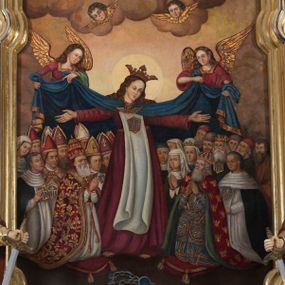
Our Lady of the Redemption of Slaves
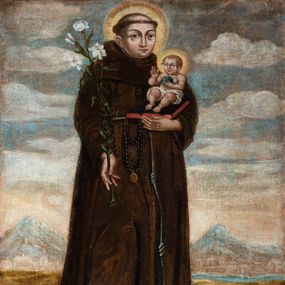
St. Anthony of Padua
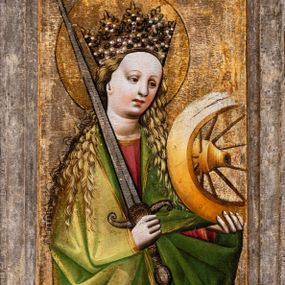
A front left wing of the old triptych of Our Lady of the Immaculate Conception
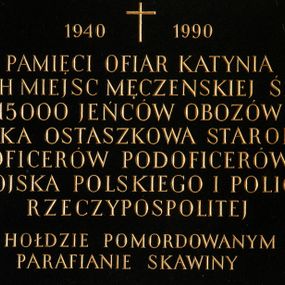
A plaque commemorating the victims of extermination
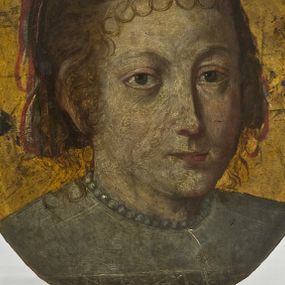
A portrait of Zofia Kochańska of the Swierczewski family
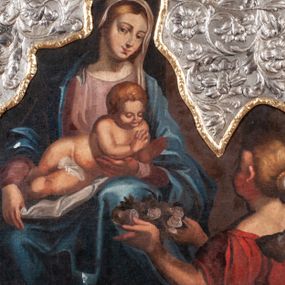
Adoration of Mary
How to cite?
Maria Działo, "Church of Saint Joachim in Skawinki", [in:] "The Sacred Lesser Poland Heritage", 2026, source: https://sdm.upjp2.edu.pl/en/works/church-of-saint-joachim-in-skawinki
